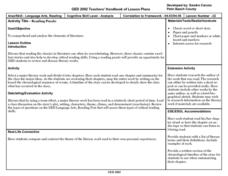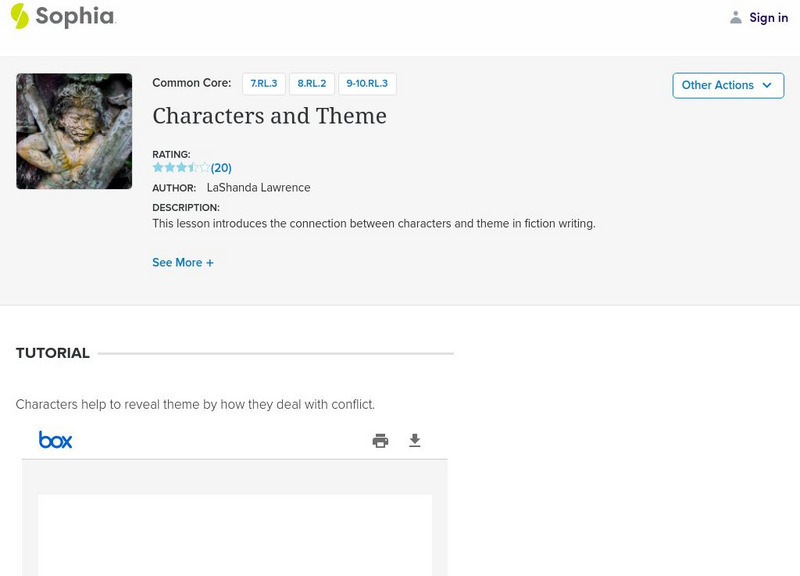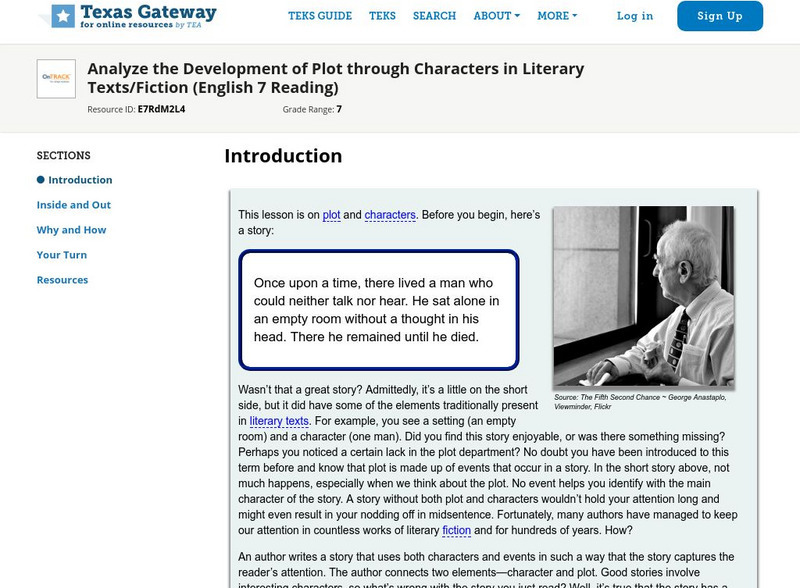Curated OER
Tracking Down Meaning in Great Expectations
Fourth graders are assigned an unique theme, symbol, or character in Great Expectations. They becomes the class expert on that facet of the novel while learning the basic skills needed to write a research paper.
Alabama Learning Exchange
Would you fit in with the Cherokees?
Students use this activity as an introduction to the unit on Cherokee Native Americans. They discuss and research Cherokee dress and homes and identify difference between the Cherokee and the individuals in the class.
Curated OER
Reading Puzzle
Twelfth graders examine the elements of literature. They each read a chapter of a novel, sequentially list the main ideas, present a summary of the chapter to the class, sequence the events, and review the novel by summarizing the timeline.
Curated OER
How Does Ancestry Affect Folklore?
Students break into groups of 4 or 5 and choose an option to demonstrate a different cultural perspective in a fairy tale or other folklore that they are familiar. Possible choices are: PowerPoint presentation, video, digital...
Curated OER
Story Parts
Third graders identify the three major parts of a story. After reading the book "Stellaluna," students discuss the beginning, middle and end of the story. They write a short story depicting the events that would happen if the story...
Curated OER
Haitian Folktales
Seventh graders identify parts of Haitian culture through folktales. They compare and contrast a Haitian folktale with an African American folktale. They read "Bye-Bye" a Haitian folktale. They create and write their own folktale. They...
Curated OER
Literature-based Skill Building: Holes by Louis Sachar
For this literature response worksheet, students answer 7 essay questions about Chapter 11 of the book called Holes by Louis Sachar.
Curated OER
Growing Pains of the Yearling
Fourth graders read The Yearling by Marjorie Kinnan Rawlings.
Curated OER
Tuck Everlasting and Economic Decision-Making
Sixth graders use a decision-making grid and list the alternatives and criteria for deciding to drink the Water of Immortality. They examine advertisements and list the product for sale, where it is sold, and why consumers should buy it,...
Curated OER
Arts have Emotional Impact
Students explore how various artists use color, line and composition to create a mood. In comparison, students explore various elements of specific art forms that affect the viewer's emotions in dance, theater music and the visual...
Curated OER
Reel or Real?
Students compare and contrast a live versus an animated performance of the same title. They view and take notes during the animated version, take a field trip to observe the live version, and write an opinion on which performance is most...
Curated OER
Voices at Whisper Bend
Students examine life in Pennsylvania during and after World War II. Using primary source documents, they compare the unity of the United States during World War II and the Iraq War. They also discover how citizens adapt to the war at home.
Curated OER
Theatre- The Critic's Review
Learners construct a critical review of a performance. In this theatrical lesson, students learn why critical reviews are important and create their own critical review. Learners discuss their review.
Texas Education Agency
Texas Gateway: Analyze Development of Plot Through Characters in Literary Text
[Accessible by TX Educators. Free Registration/Login Required] Often characters are a driving force behind the plot. In this lesson, students will learn how complex, multilayered characters contribute to the development of a story's plot...
Sophia Learning
Sophia: Characters and Theme
This lesson introduces the connection between characters and theme in fiction writing. RL.9-10.3 Analyzing Characters
Sophia Learning
Sophia: Outlining Plot
This video tutorial focuses on outlining plot; it explains that we outline plot as a way to analyze it; to analyze plot, focus on main events and interaction involving main characters. It offers three methods for outlining plot:...
Quizlet
Quizlet: R.3 Analyze How and Why Individuals, Events, or Ideas, Develop/interact
Please align to CCSS.ELA-Literacy.CCRA.R.3 Analyze how and why individuals, events, and ideas develop and interact over the course of a text.
Texas Education Agency
Texas Gateway:analyze the Development of Plot Through Characters
This learning module will take the user through examples and applications of how to indentify plot through characters in fictional texts.
Polk Brothers Foundation Center for Urban Education at DePaul University
De Paul University: Center for Urban Education: I Can Analyze a Story or History [Pdf]
This graphic organizer can be used to help students analyze a story or a historical event. Students will look closely at the story's characters or people involved in the historical event. Then they will summarize the story or event, and...
Other
Brentville District High School: The Tragedy of Julius Caesar, Act Iv [Pdf]
The teacher edition of a textbook chapter on Act 4 of The Tragedy of Julius Caesar. Students will analyze the plot, make and verify predictions, and analyze characters. Includes explanations of vocabulary with accompanying text from the...
TES Global
Tes: Scheme of Work: The Tempest by William Shakespeare
[Free Registration/Login Required] During these multi-day lessons, students will closely read William Shakespeare's work, The Tempest. Students will analyze characters, plot, and themes. Students will culminate their understanding...
PBS
Pbs Teachers: The Hound of the Baskervilles
View, read and discuss Conan Doyle's tale, "The Hound of Baskersvilles," and compare and contrast the story with the film. Explore the genres and elements of mystery and suspense that are present, and analyze characters, especially...
John F. Kennedy Center
The Kennedy Center: Arts Edge: What a Character!
In this lesson, students analyze how a character's personality traits, actions, and motives influence the plot of a story. Students also learn how storytellers use their face, body, and voice, as well as the five senses, to enhance the...
Alabama Learning Exchange
Alex: Using Fairy Tales to Teach the Short Stories
Familiar fairy tales are used as guides to help students analyze the elements of the short story: plot, theme, setting, point of view, and character.























